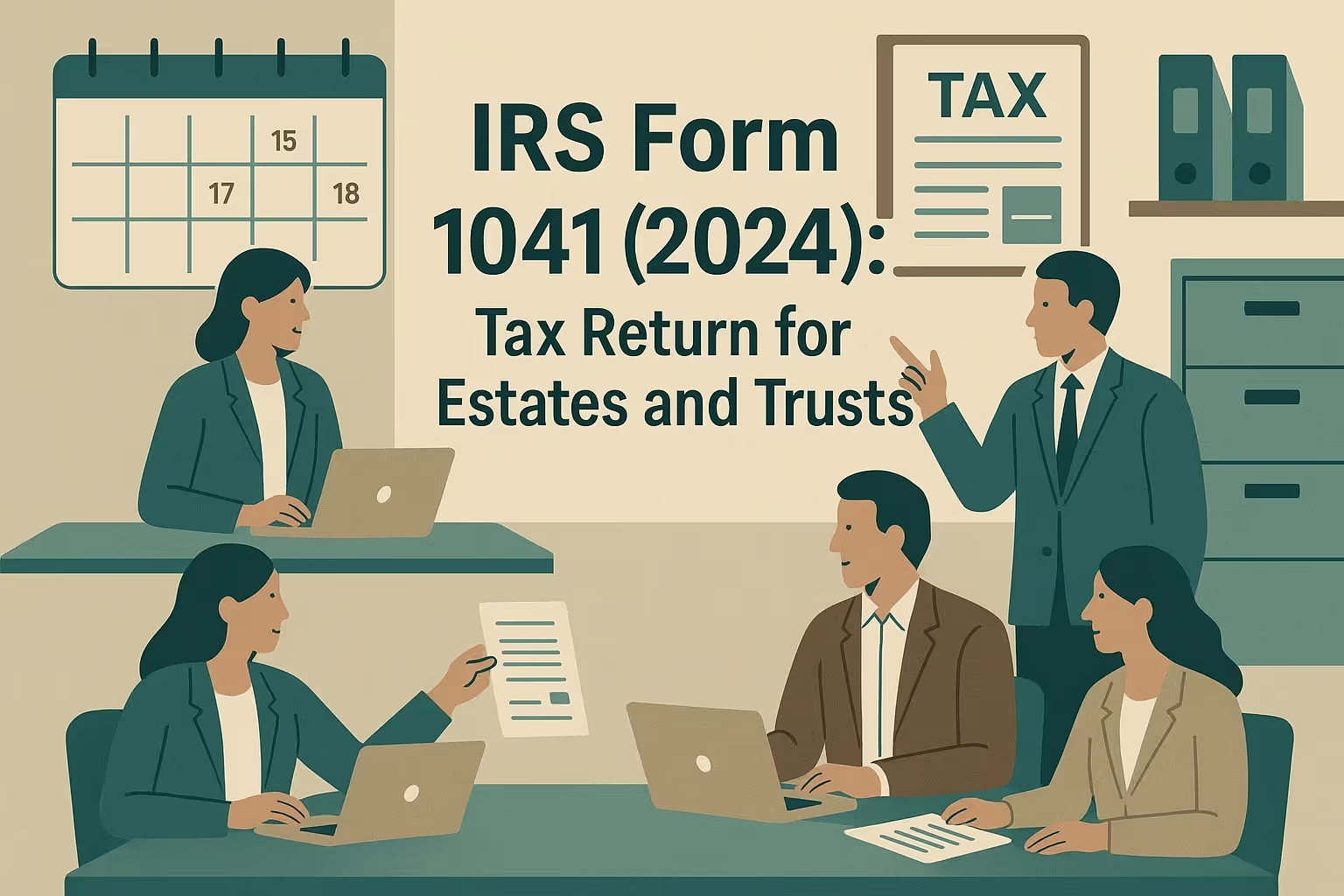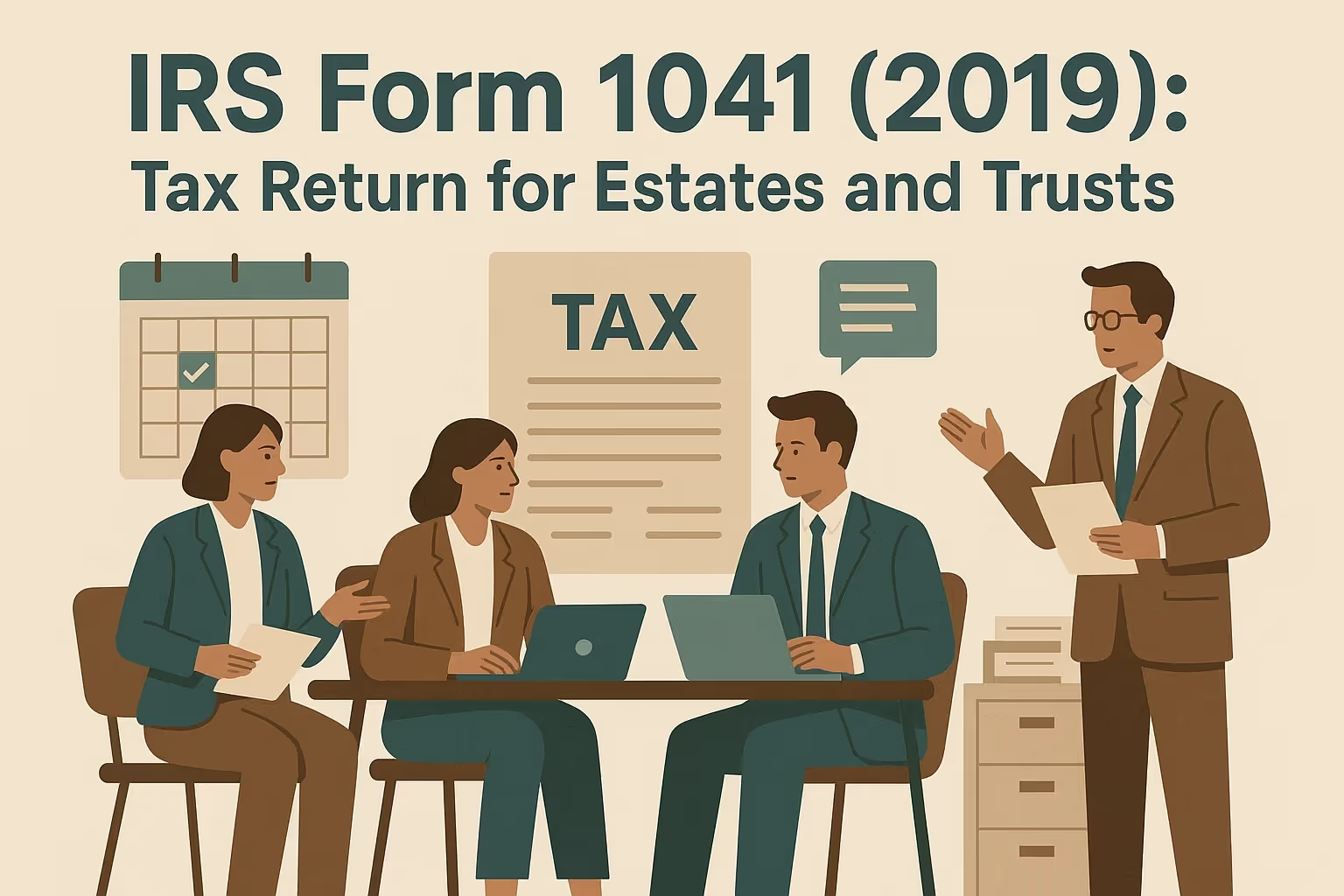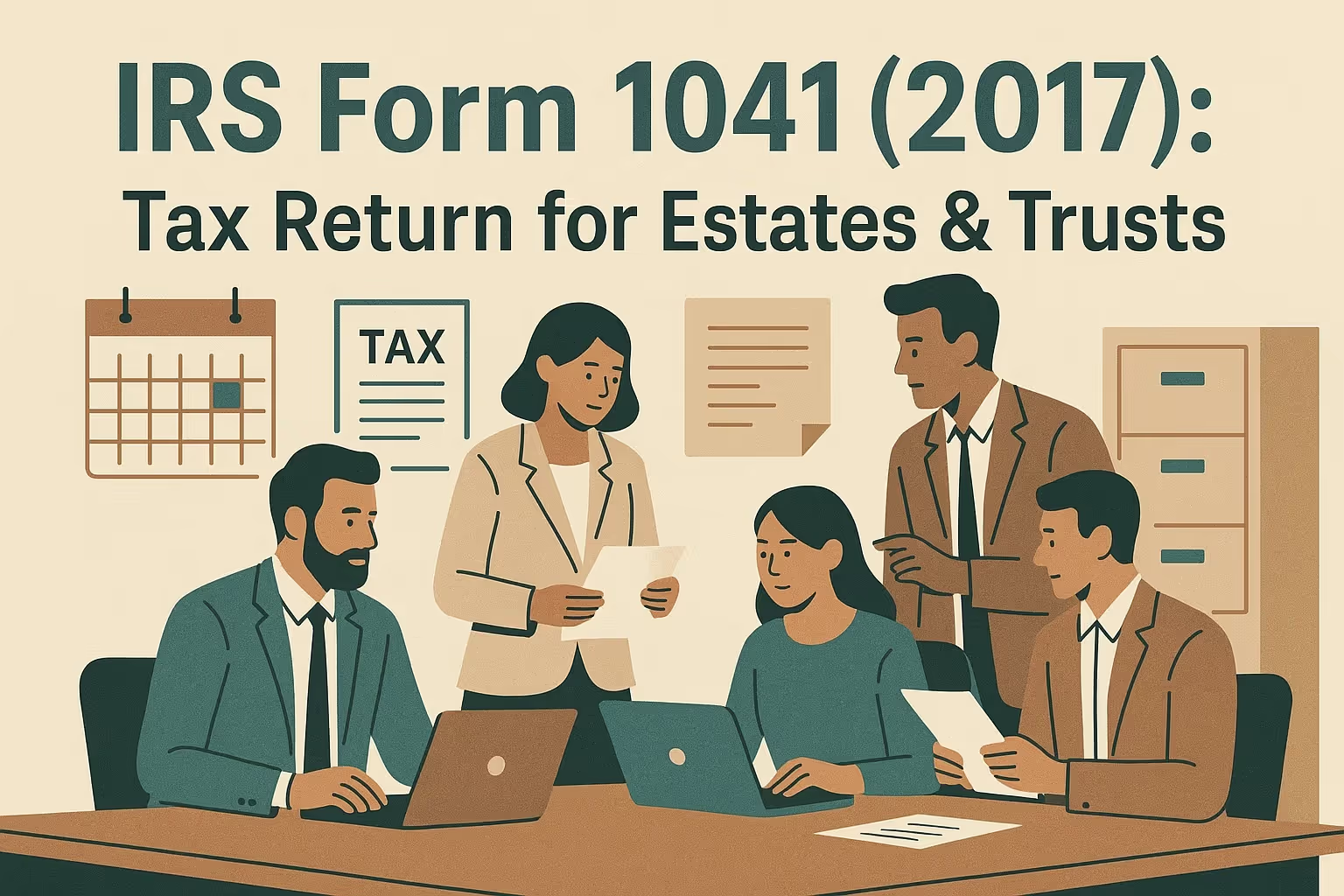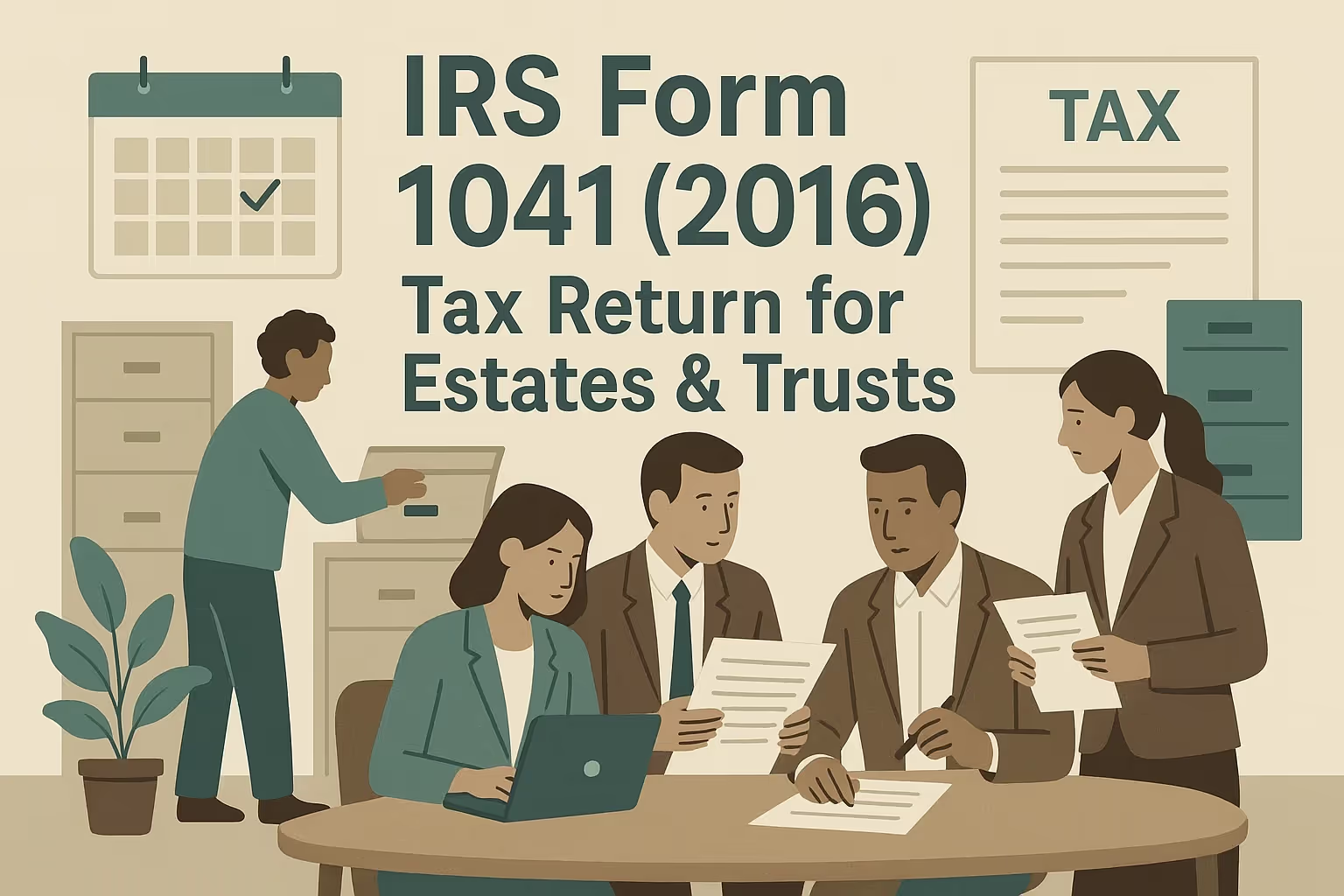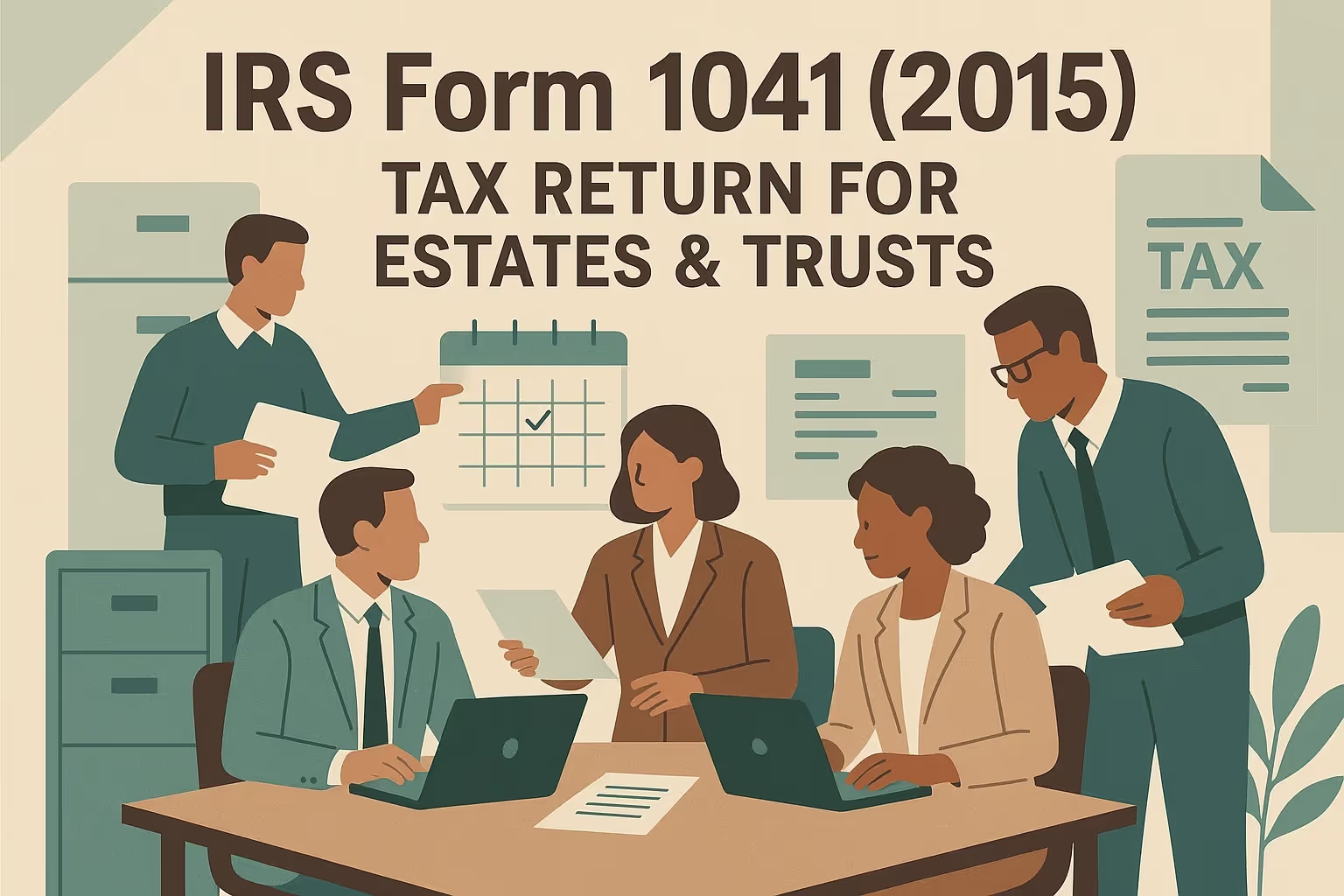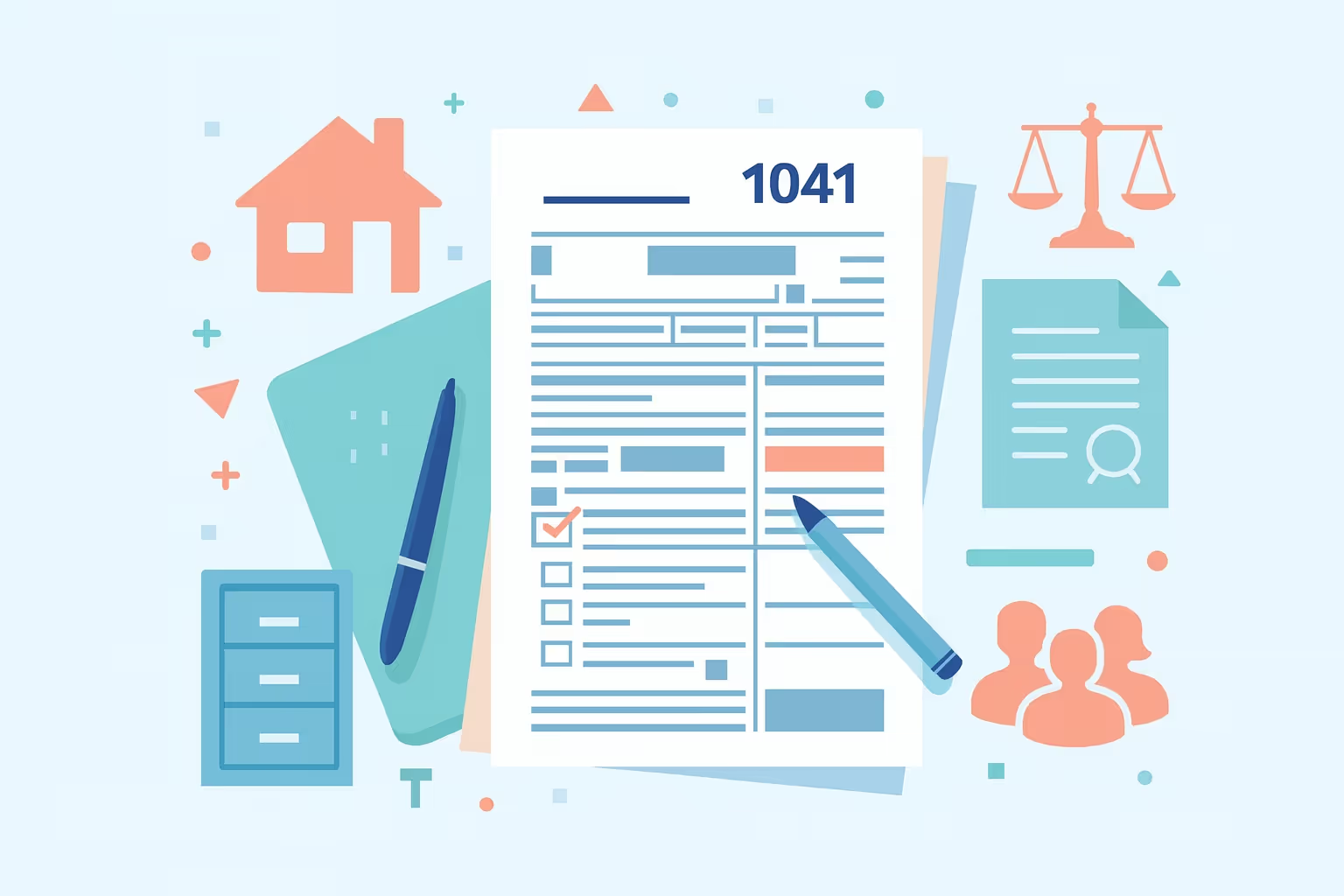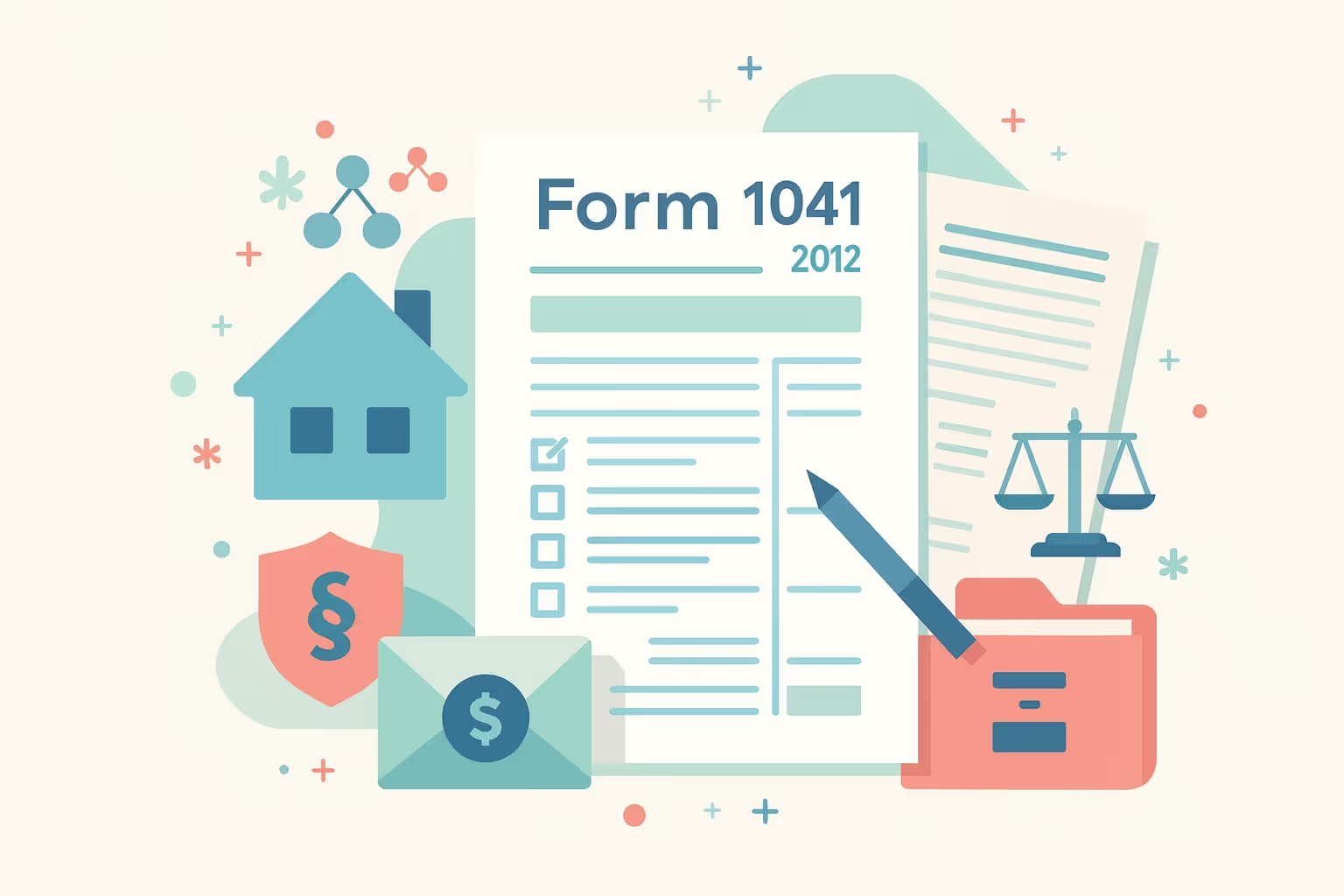Form 1041 2010 Instructions for Fiduciary Income Tax
Filing a fiduciary income tax return can be complex for fiduciaries managing an estate or trust after a person’s death. The Internal Revenue Service (IRS) requires fiduciaries, such as trustees, executors, and estate administrators, to report all gross, trust, and income distributed to beneficiaries using Form 1041. This estate tax return calculates applicable deductions, income tax liability, and any tax credits owed. Understanding how to file correctly helps fiduciaries ensure accurate reporting, protect beneficiaries, and maintain compliance with federal tax laws.
For the 2010 tax year, estates and trusts must include income generated after the decedent’s death, such as dividend income, rental property earnings, and wages paid to household employees. Fiduciaries should also account for all the assets held and transferred during the taxable year, including distributions made to resident or nonresident beneficiaries. When managing irrevocable, revocable, or living trusts, fiduciaries must apply the correct tax rates and accurately report income taxation. Proper preparation helps avoid errors and ensures that each income source is fully documented.
The Official IRS Form 1041 Instructions for 2010 outline filing requirements, applicable deductions, and recordkeeping rules for estates and trusts. With organized documentation and careful attention to each line item, fiduciaries can complete the return confidently and submit a compliant filing.
What Is IRS Form 1041?
Form 1041 is the fiduciary income tax return used to report income earned by an estate or trust after a person’s death. It documents all gross income, income distributed, and trust income generated from assets such as rental property, dividend income, and wages paid to household employees.
Fiduciaries, whether trustees, executors, or estate administrators, must use this tax form to calculate income tax liability, applicable deductions, and tax credits. Filing ensures transparency and compliance under Internal Revenue Service guidelines for fiduciary income taxation.
This form applies to multiple fiduciary entities with specific reporting thresholds and obligations. Estates and trusts must determine their filing status based on income levels, residency, and income generated. Understanding these criteria prevents errors and ensures every dollar is correctly accounted for within the taxable year.
Entities Required to File Form 1041:
- Resident Estate: A resident estate must file Form 1041 when its gross income reaches $600 or more within the taxable year.
- Nonresident Estate: A nonresident estate must file Form 1041 if it earns taxable income or includes at least one nonresident beneficiary.
- Resident Trust: A resident trust must file Form 1041 when it earns income, regardless of the income’s source or type.
- Nonresident Trust: A nonresident trust must report all U.S.-sourced income and any distributions made to beneficiaries.
- Grantor, Revocable, or Irrevocable Trusts: Grantor, revocable, and irrevocable trusts each have distinct reporting rules that depend on the nature of ownership and control.
The form determines the distributable net income and calculates the income distribution deduction for beneficiaries, ensuring that income taxation aligns with the allocation of funds among recipients. Fiduciaries must review trust documents or estate provisions to confirm which amounts qualify as income distributed versus assets retained.
Filing Form 1041 provides a complete picture of fiduciary activity, covering income earned, assets distributed, and applicable deductions. Accurate reporting fosters trust among beneficiaries and ensures compliance with federal filing standards for estates and trusts.
Key Tax Changes for 2010
Fiduciaries filing Form 1041 for tax year 2010 must understand several updates influencing estate and trust reporting. These revisions affect how gross income, trust income, and assets distributed are documented under federal requirements.
Applying these changes correctly supports accurate calculation of income tax liability, the use of applicable deductions, and compliance with Internal Revenue Service regulations. Reviewing each modification helps fiduciaries strengthen reporting practices and avoid common errors in fiduciary income taxation.
New Payment Voucher Implementation
The IRS introduced the Form 1041-V Payment Voucher for 2010 to enhance the process of fiduciaries paying income tax. This payment tool matches each remittance to the correct estate or trust account, minimizing crediting mistakes. Fiduciaries managing multiple entities benefit from the voucher’s structured format, which facilitates precise recordkeeping and timely payment posting.
Estate Tax Reinstatement under Public Law 111-312
Federal estate taxes were reinstated for 2010, affecting the estates of many decedents with significant net worth. Fiduciaries could elect either the reinstated estate tax or a modified carryover basis method. This option allowed estate administrators to align their estate tax return with the most suitable tax position while ensuring compliance with statutory requirements.
Adjusted Exemptions and Deduction Options
Qualified disability trusts could claim an exemption of up to $3,650. Bankruptcy estates were required to file only when their gross income equaled or exceeded $9,350. The extension of state and local sales tax deductions applied to estates managing income from property transactions, trust assets, or household employees.
Clarified Filing Requirements for Complex Entities
We updated the definitions for complex trusts, irrevocable trusts, and fiscal-year estates. Fiduciaries managing these entities must reassess distribution schedules, income allocation, and future plans. These adjustments reinforced the accuracy of the income distribution deduction and distributable net income calculations.
These collective updates refined reporting standards for 2010, ensuring estates and trusts maintained accurate fiduciary income taxation records. Understanding these revisions helps fiduciaries complete each estate tax return precisely and uphold compliance across all income categories.
Preparation Before Filing Form 1041
Fiduciaries must prepare thoroughly before completing Form 1041 to ensure the estate or trust filing is accurate and complete. Proper preparation establishes a clear record of income generated, applicable deductions, and tax credits claimed during the taxable year.
A well-documented filing process protects fiduciaries, beneficiaries, and estate administrators and demonstrates compliance with Internal Revenue Service regulations. Organized preparation also prevents delays and supports accurate reporting of gross income, trust income, and distributed income.
Every fiduciary should create a comprehensive filing plan that covers income identification, documentation, and classification. Establishing clear records for all trust assets and estate transactions ensures that each dollar earned, spent, or distributed is accurately accounted for and tracked. Preparation begins with confirming the entity’s tax year and reviewing all financial activities from the decedent’s death through the close of the reporting period.
- Obtain an Employer Identification Number (EIN) from the Internal Revenue Service before filing. The EIN distinguishes the estate or trust from the decedent’s personal income tax return and must be used on all federal filings and payments.
- Submit Form 56 to notify the Internal Revenue Service of the fiduciary relationship. This establishes your authority to act on behalf of the decedent’s estate or trust and ensures proper communication between the fiduciary and the agency.
- Review the trust document or will to identify how income generated during the taxable year should be allocated. The governing instrument outlines how assets distributed, retained, or earmarked for future distribution must be treated for income taxation purposes.
- Gather all income records related to trust assets and estate operations. Include 1099s, K-1s, bank statements, and reports for rental property, dividend income, interest-bearing accounts, and wages paid to household employees.
- Organize detailed expense documentation for every deductible cost incurred during the administration period. Keep receipts, invoices, and contracts for fiduciary fees, legal services, accounting support, and any payments tied to estate or trust operations.
- Identify all applicable deductions that may reduce the estate’s or trust’s income tax liability; review eligibility for charitable contributions, administrative expenses, and state or local taxes paid on income earned.
- Confirm the accounting method used for reporting purposes. Determine whether the estate or trust follows a calendar or fiscal year schedule to ensure consistent reporting across all income and distributions.
Maintaining detailed records throughout preparation allows fiduciaries to verify calculations for the income distribution deduction and ensures accurate reporting across all schedules. Organized groundwork supports an efficient filing process and demonstrates fiduciary diligence in income taxation.
How to Complete Form 1041 Step by Step
Fiduciaries completing Form 1041 must carefully document every financial activity within the estate or trust. The process involves reporting gross income, identifying applicable deductions, calculating income tax liability, and accurately recording each income source. Each section of the form serves a specific purpose, ensuring the Internal Revenue Service receives a complete record of income generated and assets distributed. Following these steps ensures compliance and gives beneficiaries a transparent view of fiduciary income taxation.
Step 1: Enter Header Information
Start by completing the entity identification section at the top of Form 1041. Include the official name of the estate or trust, the Employer Identification Number (EIN), and the address of the fiduciary or estate administrator.
Select the entity type, whether a decedent’s estate, simple trust, or complex trust. Check all applicable boxes, such as “Initial Return,” “Final Return,” or “Change in Fiduciary.” This section establishes the filing entity and confirms whether the return applies to a resident trust, nonresident trust, or estate.
Step 2: Report All Income
Lines 1 through 9 include every income category earned during the taxable year. Report interest income from bank accounts, bonds, or certificates of deposit. Include dividend income from investments, rental property revenue, and any business or farm income associated with the estate or trust. Add gains or losses from capital transactions, partnership interests, or other trust assets. These amounts represent the total gross income, forming the foundation for calculating tax liability.
Step 3: Record Allowable Deductions
Lines 10 through 16 capture deductions that reduce taxable income. Report fiduciary fees, attorney fees, and accounting expenses incurred while managing the estate or trust. Include taxes paid, such as state income taxes or property taxes, that qualify as applicable deductions.
List charitable contributions, interest, and other authorized expenses tied directly to estate or trust operations. Maintaining receipts and documentation supports these deductions and ensures their accuracy under IRS review.
Step 4: Compute Adjusted Total Income
Calculate the adjusted total income on Line 17 by subtracting total deductions from gross income. This figure represents the income generated after deducting expenses and establishes the basis for further reductions or adjustments. Proper calculation ensures all applicable deductions are considered before determining the taxable portion of revenue.
Step 5: Apply the Income Distribution Deduction
Enter the income distribution deduction on Line 18 using Schedule B. This section measures the distributable net income (DNI) allocated to beneficiaries. Reporting these distributions correctly transfers the associated income taxation from the fiduciary to each beneficiary, aligning tax liability with actual income distributed.
Step 6: Determine Exemptions and Taxable Income
Lines 19 through 22 list exemptions based on entity type. Estates qualify for a $600 exemption, while complex and simple trusts receive lower amounts. Subtract exemptions and distribution deductions from adjusted total income to identify taxable income. Apply current tax rates for estates and trusts to calculate the amount owed.
Step 7: Calculate Total Tax and Payments
Lines 23 through 29 summarize tax computation and payments. Include estimated payments made during the year, tax withheld from income sources, and credits available to the entity. The remaining balance represents the income tax liability due with the return.
Completing Form 1041 systematically ensures every income source, deduction, and distribution is reported accurately. Careful attention to each line item reduces the risk of errors and supports transparent financial reporting for all parties involved in estate and trust administration.
Filing Options and Payment Methods
When submitting Form 1041, fiduciaries must select the most suitable filing and payment method. The chosen method should align with the complexity of the estate or trust, the recordkeeping needs, and the available resources.
Accurate and timely submission is essential for proper processing under Internal Revenue Service regulations, whether filing electronically or on paper. Understanding each option helps fiduciaries manage income tax liability effectively while maintaining compliance with fiduciary income taxation standards.
Electronic Filing
- Submit Form 1041 through IRS-approved e-file providers using secure electronic platforms.
- Obtain authorization using Form 8879-F for an electronic signature or Form 8453-F if mailing signed copies separately.
- Validate all gross income, trust income, and applicable deductions before submission to ensure error-free processing.
- Receive immediate confirmation that the Internal Revenue Service accepted the fiduciary income tax return, allowing faster resolution of potential discrepancies.
- Select electronic filing when managing multiple entities, as it streamlines reporting for estates and trusts with complex financial activities.
Paper Filing
- Print all completed pages of Form 1041, ensuring clarity and consistent formatting across schedules and attachments.
- Review each section to confirm accurate reporting of income generated, assets distributed, and income provided to beneficiaries.
- Before mailing, sign and date the return as the fiduciary, executor, or estate administrator.
- Include supporting schedules, such as Schedule K-1, documenting each beneficiary’s share of distributable net income.
- Mail the package to the Internal Revenue Service center designated for the entity’s location, using certified mail for tracking purposes.
Payment Options
- Attach a check or money order payable to the “United States Treasury” if paying with a paper return. Include the estate or trust EIN and “Form 1041” on the memo line for proper crediting.
- Initiate an electronic funds withdrawal when e-filing to ensure immediate payment and prevent delays in processing.
- Use the Electronic Federal Tax Payment System (EFTPS) for secure payment scheduling, particularly for entities with recurring income tax obligations.
- Verify that the payment covers the entire income tax liability for the taxable year to avoid future notices or interest charges.
Selecting the proper filing and payment approach helps fiduciaries maintain accurate records and demonstrate compliance with all tax requirements. Careful attention to deadlines and payment details ensures every estate or trust fulfills its federal obligations on time.
Required Schedules and Attachments
Fiduciaries must include all relevant schedules and attachments when filing Form 1041 to provide a comprehensive estate or trust activity record. Each schedule serves a specific purpose, ensuring that every aspect of gross income, applicable deductions, and income distributed is documented.
Including these forms supports compliance with Internal Revenue Service requirements and offers transparency to beneficiaries regarding distributable net income and tax allocations. The following table outlines the most common schedules and their corresponding functions.
- Purpose: Reports charitable deductions claimed by the estate or trust
- Key Details: Used when the entity makes qualified donations to charitable organizations; applies to complex trusts and estates with authorized charitable bequests
- Purpose: Calculates the income distribution deduction
- Key Details: Determines distributable net income (DNI) and how much income is distributed to beneficiaries; essential for entities making current or future distributions
- Purpose: Computes total tax liability
- Key Details: Summarizes income tax liability, including credits, AMT, and income-related adjustments
- Purpose: Reports each beneficiary’s share of income, deductions, and credits
- Key Details: Required for every beneficiary receiving distributed income; ensures consistency between the fiduciary return and beneficiary personal returns
- Purpose: Records capital gains and losses
- Key Details: Used for investment transactions, property sales, or asset transfers; distinguishes short-term vs. long-term gains
- Purpose: Lists income from rental property, royalties, partnerships, and S corporations
- Key Details: Ensures accurate reporting of pass-through income and related deductions from estate or trust assets
- Purpose: Calculates accumulation distributions
- Key Details: Used when prior-year income is distributed in the current year; supports accurate tracking of deferred tax obligations
Fiduciaries must review all schedules before submission to confirm accuracy across reported income and deductions. Each attachment supports the figures on Form 1041 and clarifies how income, trust assets, and deductions are allocated. Complete documentation strengthens the estate or trust’s compliance position and prevents future disputes with the Internal Revenue Service or beneficiaries.
Common Mistakes and Filing Best Practices
Fiduciaries responsible for preparing Form 1041 must ensure accuracy at every stage of the filing process. Even a single oversight can result in income tax liability errors, delayed processing, or correspondence from the Internal Revenue Service.
Understanding common mistakes and applying preventive measures helps fiduciaries comply with federal tax requirements and maintain transparency in fiduciary income taxation.
- Incorrect Entity Classification: Misclassifying a simple trust, complex trust, or grantor trust changes how gross income, deductions, and income distributed are reported. Review the governing trust document or will before filing to determine the correct entity type and ensure income taxation aligns with federal rules.
- Missing or Invalid Employer Identification Number (EIN): Using a decedent’s Social Security Number instead of the estate or trust EIN leads to processing delays or rejection. The EIN identifies the fiduciary entity and must appear consistently on all pages, attachments, and schedules within the fiduciary income tax return.
- Incomplete or Inaccurate Schedule K-1 Forms: Each beneficiary receiving income distributed must receive a complete and accurate Schedule K-1. Errors or omissions can create inconsistencies in reporting between beneficiary and fiduciary filings. Verify each beneficiary’s share and distributable net income, and identify information before distribution.
- Double-Counting Income: Reporting the same income on the decedent’s final personal return and the estate’s fiduciary return inflates taxable income. Maintain clear records to separate pre-death and post-death income, ensuring accurate allocation across all filings and schedules.
- Unverified Deductions and Expenses: Claiming deductions without valid documentation increases the likelihood of review and audit. Maintain organized records for fiduciary fees, administrative expenses, and legal or accounting costs directly tied to trust assets or estate operations.
- Unfiled Amended Return: If an error is discovered after submission, promptly file Form 1041-X to correct it. Timely amendments demonstrate compliance and prevent additional notices or adjustments from the Internal Revenue Service.
IRS Publication 559 (2010): Survivors, Executors, and Administrators provides guidance to help fiduciaries prepare accurate filings and correct errors effectively. Implementing these best practices promotes accurate reporting, ensures compliance with Internal Revenue Service regulations, and strengthens confidence among beneficiaries. Accurate classification, complete documentation, and timely correction of errors collectively form the foundation of sound fiduciary filing.
Frequently Asked Questions
What is a fiduciary income tax return, and who must file it?
A fiduciary income tax return, filed using Form 1041, reports income earned by an estate or trust after a person passes. The personal representative, executor, or trustee must file when the entity earns $600 or more in gross income during the taxable year. This filing also applies to estates and trusts with a nonresident beneficiary or any entity managing assets distributed among multiple beneficiaries.
How does a personal representative handle gift taxes within an estate or trust?
Gift taxes may apply when an estate or trust transfers property to beneficiaries outside regular distributions. The personal representative must ensure that all transfers, including real estate and other assets, comply with Internal Revenue Service guidelines. Gift tax reporting is separate from income reporting, but accurate documentation ensures transparency. Entities such as grantor trusts and complex trusts must also maintain detailed records of gifts made from trust assets.
What happens to taxable income when a person passes during the year?
When a person passes, income earned before death appears on the decedent’s final personal return, while income earned afterward transfers to the estate or trust. The fiduciary filing Form 1041 must include all post-death income under fiduciary income taxation rules. This process ensures accurate tax allocation across returns and preserves the beneficiary’s share of income distributed from the estate.
How are assets distributed to beneficiaries from estates and trusts?
Assets distributed from estates and trusts must follow the provisions of the governing will or trust document. The fiduciary reports all income-generating distributions, ensuring that each beneficiary’s share receives proper tax treatment. When managing cash, investments, or real property, fiduciaries must document distributions using fair market value. Accurate reporting protects beneficiaries and ensures compliance under fiduciary income taxation standards.
Do complex trusts calculate taxes differently from simple or grantor trusts?
Complex trusts can accumulate income, make charitable contributions, and distribute both income and principal, creating more detailed calculations for tax reporting. These trusts often include varying distribution requirements that affect taxable income and may result in one-time tax obligations. Fiduciaries must review trust terms carefully and apply the correct rules for income retention, distributions, and deductions under current federal guidelines.
Can a farmer pass scenario affect estate or trust reporting?
When a farmer passes, the estate or trust must report income from farming operations for the remainder of the taxable year. The fiduciary includes all earnings, expenses, and applicable deductions on the fiduciary income tax return. If agricultural property or equipment counts among the estate’s broad categories of assets, those items must also appear in the estate’s valuation and reporting schedules.
How does an estate or trust report a one-time tax obligation?
A one-time tax may apply when estates or trusts realize specific gains from the sale of property or other assets. The fiduciary must include these amounts on Form 1041 and ensure accurate calculation within total income. Such obligations may also occur when entities transfer property during administration. Properly documenting these events supports compliance with fiduciary income taxation requirements and prevents reporting errors.






